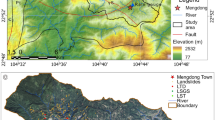Abstract
The mining subsidence basins are mostly irregular. The traditional method is difficult to achieve quantitative evaluation of mining subsidence damage. This paper investigated the quantitative indicators of land subsidence damage evaluation based on GIS. The calculation method of the area and volume of surface subsidence caused by underground mining was proposed. Firstly, the principle, requirements, methods and steps of drawing the sinking boundary line were given. A calculation method based on the subsidence area of the surface subsidence database was proposed. According to the sinking contour map, the calculation method of subsidence area based on the sinking contour map was proposed. Based on the calculation method of surface subsidence area and and the digital elevation model, the calculation method of the mining subsidence volume was put forward. The surface subsidence area and volume were calculated by numerical examples. This realized the quantitative evaluation of surface subsidence damage caused by underground coal mining, and promoted the application of GIS in mining damage assessment.











Similar content being viewed by others
References
Blachowski J (2016) Application of GIS spatial regression methods in assessment of land subsidence in complicated mining conditions: case study of the Walbrzych coal mine (SW Poland). Nat Hazards 84(2):997–1014
Chugh YP (2018) Concurrent mining and reclamation for underground coal mining subsidence impacts in China. Int J Coal Sci Technol 5(1):18–35
Craynon JR, Karmis ME, Sarver EA, Ripepi NS (2016) A GIS-based methodology for identifying sustainability conflict areas in mine design-a case study from a surface coal mine in the USA. Int J Min Reclam Environ 30(3):197–208
Esaki T, Djamaluddin I, Mitani Y (2008) A GIS-based prediction method to evaluate subsidence- induced damage from coal mining beneath a reservoir, Kyushu, Japan. Q J Eng Geol Hydrogeol 41(3):381–392
Han F, Zhang Y (2017) Distribution characteristic and migration pathways of metals in subsidence zone in a coal mine, China. Bull Environ Contam Toxicol 98(4):539–545
Howladar MF (2016) Environmental impacts of subsidence around the Barapukuria Coal Mining area in Bangladesh. Energy Ecol Environ 1(6):370–385
Karan SK, Samadder SR, Maiti SK (2016) Assessment of the capability of remote sensing and GIS techniques for monitoring reclamation success in coal mine degraded lands. J Environ Manage 182:272–283
Kim KD, Lee S, Oh H-J, Choi J-K, Won J-S (2006) Assessment of ground subsidence hazard near an abandoned underground coal mine using GIS. Environ Geol 50(8):1183–1191
Li SS, Sun Z (2018) Impact of reclamation in coal mining subsidence area on urban spatial expansion of Huaibei City. Asian Agric Res 10(8):42–49
Lv WY (2016) The mitigation of surface subsidence in coal mines. Energy Environ 27(3–4):350–359
Marschalko M, Yilmaz I, Kubecka K, Bouchal T, Bednarik M, Drusa M, Bendova M (2015) Utilization of ground subsidence caused by underground mining to produce a map of possible land-use areas for urban planning purposes. Arab J Geosci 8(1):579–588
Oh H-J, Ahn S-C, Choi J-K, Lee S (2011) Sensitivity analysis for the GIS-based mapping of the ground subsidence hazard near abandoned underground coal mines. Environ Earth Sci 64(2):347–358
Salmi EF, Nazem M, Karakus M (2017) Numerical analysis of a large landslide induced by coal mining subsidence. Eng Geol 217:141–152
Song Z, Hao J, Shi Y, Tang J, Liu J (2019) An overview of connotation and development of practical ground pressure contorl theory. J Shandong Univ Sci Technol(Nat Sci) 38(1):1–15
Suh J, Choi Y, Park H-D, Yoon S-H, Go W-R (2013) Subsidence hazard assessment at the Samcheok Coalfield, South Korea: a case study using GIS. Environ Eng Geosci 19(1):69–83
Suh J, Choi Y, Park H-D (2016) GIS-based evaluation of mining-induced subsidence susceptibility considering Sun, 3D multiple mine drifts and estimated mined panels. Environ Earth Sci 75(890):1–19
Sun W, Zhang Q, Luan Y, Zhang XP (2018) A study of surface subsidence and coal pillar safety for strip mining in a deep mine. Environ Earth Sci 77(17):627–635
Unlu T, Akcin H, Yilmaz O (2013) An integrated approach for the prediction of subsidence for coal mining basins. Eng Geol 166:186–203
Vaziri V, Khademi Hamidi J, Sayadi AR (2018) An integrated GIS- based approach for geohazards risk assessment in coal mines. Environ Earth Sci 77(1):29
Wang JM, Jiao ZZ, Bai ZK (2014) Changes in carbon sink value based on RS and GIS in the Heidaigou opencast coal mine. Environ Earth Sci 71(2):863–871
Xia YP, Wang YJ, Du S, Liu XX, Zhou HY (2018) Integration of D-InSAR and GIS technology for identifying illegal underground mining in Yangquan District, Shanxi Province, China. Environ Earth Sci 77(8):319
Yu Q, Zhang H, Deng W, Zou Y (2018) The non-symmetric shape of surface subsidence caused by mining. J Shandong Univ Sci Technol(Nat Sci) 37(4):42–48
Zingano A, Weiss A (2019) Subsidence over room and pillar retreat mining in a low coal seam. Int J Min Sci Technol 29(1):51–57
Author information
Authors and Affiliations
Corresponding author
Additional information
Publisher's Note
Springer Nature remains neutral with regard to jurisdictional claims in published maps and institutional affiliations.
Rights and permissions
About this article
Cite this article
Li, Y., Liu, L., Li, Y. et al. Quantitative Calculation Method Surface Subsidence Caused by Underground Mining Based on GIS. Geotech Geol Eng 38, 61–69 (2020). https://doi.org/10.1007/s10706-019-00998-8
Received:
Accepted:
Published:
Issue Date:
DOI: https://doi.org/10.1007/s10706-019-00998-8




